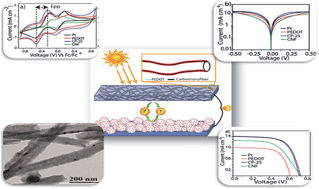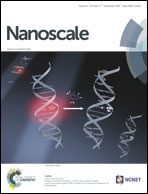Enhanced catalytic activity of polyethylenedioxythiophene towards tri-iodide reduction in DSSCs via 1-dimensional alignment using hollow carbon nanofibers†
Abstract
Here, we report a highly conducting 1-dimensionally (1-D) aligned polyethylenedioxythiophene (PEDOT) along the inner and outer surfaces of a hollow carbon nanofiber (CNF) and its application as a counter electrode in a dye sensitized solar cell (DSSC). The hybrid material (CP-25) displays a conversion efficiency of 7.16% compared to 7.30% for the standard Pt counter electrode, 4.48% for bulk PEDOT and 5.56% for CNF. The enhanced conversion efficiency of CP-25 is attributed to the accomplishment of high conductivity and surface area of PEDOT through the 1-D alignment compared to its bulk counterpart. Reduced charge transfer resistance and high conductivity of CP-25 could be proven by cyclic voltammetry, impedance analysis and Tafel experiments. Further, through a long-term stability test involving efficiency profiling for 20 days, it is observed that CP-25 possesses excellent durability compared to the bulk PEDOT.


 Please wait while we load your content...
Please wait while we load your content...